For thermal performance the GTX980 was tested on our thermal bench. This consisted of a 4930K on a Rampage IV Gene motherboard running Windows 7 on a Samsung 840 Pro SSD. Power was provided by a Corsair AX1200. Memory was GSkill 4x8GB 1866-CL11. Thermal monitoring was provided by an Aquaero 6. Temperatures of the Aquaero sensors and GPU sensors were logged by HWInfo. 347.52 WHQL Drivers were used. MSI Afterburner was used to downclock the GPU to a miserable 1151MHz. Furmark was used to load the GPU at 118% of it’s power limit (121% is the maximum power the card can draw). Furmark is used in the higher power burn mode to give a very consistent load over time. This is far more consistent than running Valley for example where GPU load is not as constant as it could be.
In previous water block reviews for GPUs we’ve flashed a modified bios to the GPU to enable us to achieve a higher power limit and test the card at higher power. These readily available bioses were used by many enthusiasts and so we felt it was a “fair” setup. However for the GTX980 there is currently no bios for the reference card that enables this. For this reason we are stuck with NVidia’s absurdly low power limit. The only way to get around this currently is to modify the PCB itself which we think many enthusiasts will not be willing to do. Therefore, likewise we did not do this. This means that the power used (and therefore cooled) by the GPU is so low that a waterblock is not necessary. EVGA’s ACX cooler ran almost silently under the same load and the GPU remained at a moderate 40C over ambient.
This also means that the GPU temperatures with a waterblock are so low that the relative margin of error is huge. To combat the error we measure across seven different flow points – this also give us insight to how the cooling responds with flow. In previous GPU block reviews we’ve also lost a *lot* of GPUs. Installing multiple blocks multiple times coupled with high power levels can quickly kill a card. Because of this we stick to one mount of the block on the GPU. This means that the test data is susceptible to a poor mount. However the TIM used (arctic cooling MX2 – not the included TIM with the block which may be good or bad) is inspected to ensure a good spread. If a good spread is not achieved an immediate re mount is done.
To further reduce errors the core temperature is measured relative to the coolant. Air temperatures are not measured because they are so prone to error. Ambient temperatures are not controlled and are another source of error. As NVidia do not give us access to VRM temperatures a temperature probe is mounted to the PCB in the middle of the VRM section. It should be noted that actual on silicon temperatures will of course be worse than this probe which is not well insulated from the block’s cooling.
As can be seen not all RAM modules made good contact on the first mount attempt and had to be touched up later.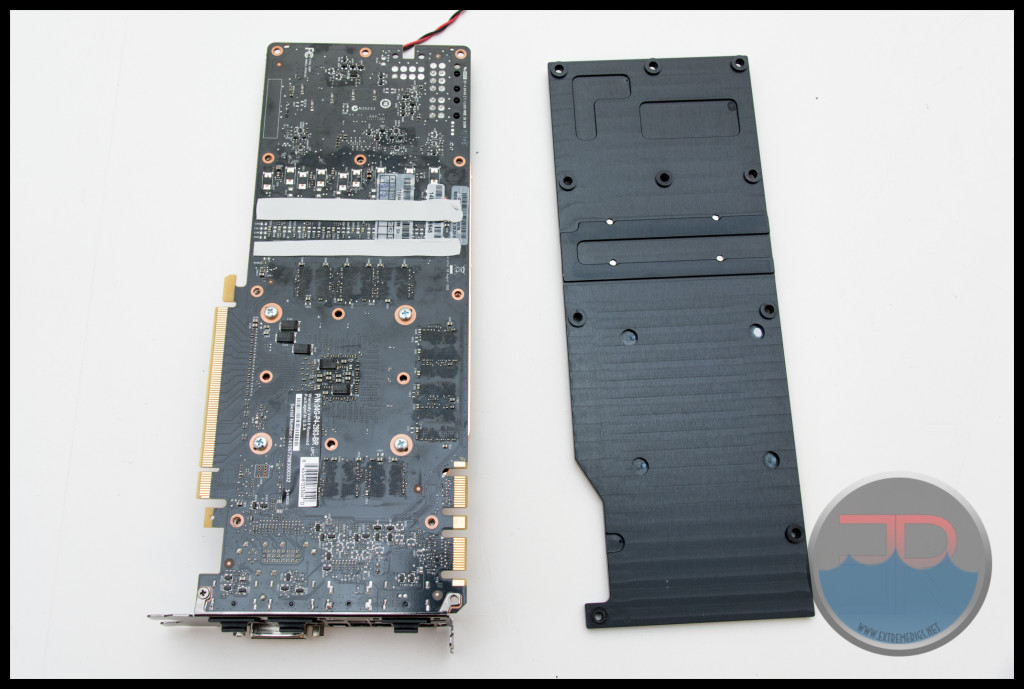
Core Cooling
The GPU core itself generates the most heat of course and we were excited to see how Aqua Computer performed. As expected performance still increases across the flow range of interest:
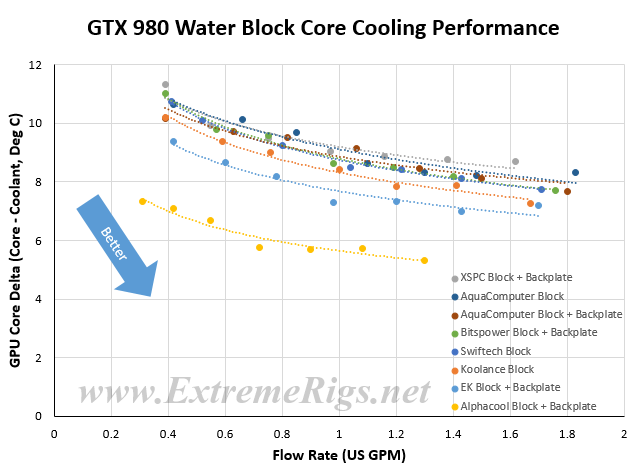 Here we can see that Aqua Computer is near the tail of the group. This was a surprise and so we tested with and without the backplate to be sure. While cooling is acceptable it could definitely be improved. We suspect this may be partly because the screws again run out of thread before hitting what we could consider the ideal mounting pressure.
Here we can see that Aqua Computer is near the tail of the group. This was a surprise and so we tested with and without the backplate to be sure. While cooling is acceptable it could definitely be improved. We suspect this may be partly because the screws again run out of thread before hitting what we could consider the ideal mounting pressure.
TIM
Traditionally I’ve only looked at block performance with MX2 TIM, however manufacturers generally supply TIM with the block and so this time I decided to test that. As Aqua Computer did not include any TIM then this plot is not so relevant.
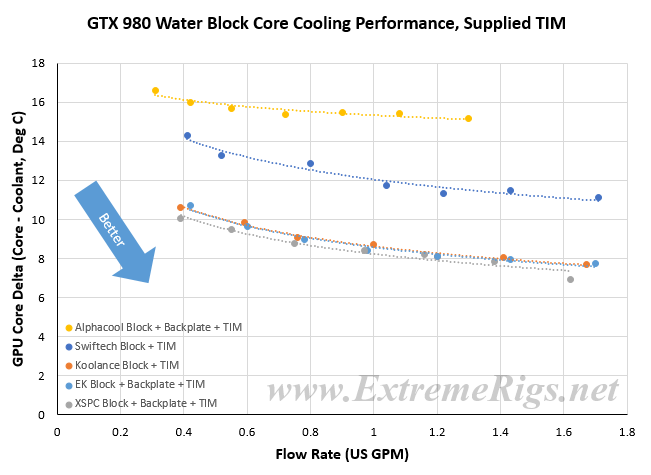 This testing allowed 4 hours for TIM burn in which is simply not enough for some TIMs. However we now see that Koolance, EK and XSPC are all essentially the same when using their own TIM. Swiftech and Alphacool have TIM that is either horrible or has a long curing time. Given the low power nature of the GTX980, we suspect it’s simply a long curing time.
This testing allowed 4 hours for TIM burn in which is simply not enough for some TIMs. However we now see that Koolance, EK and XSPC are all essentially the same when using their own TIM. Swiftech and Alphacool have TIM that is either horrible or has a long curing time. Given the low power nature of the GTX980, we suspect it’s simply a long curing time.
We can then compile all these data points into averages which should take some of the error out:
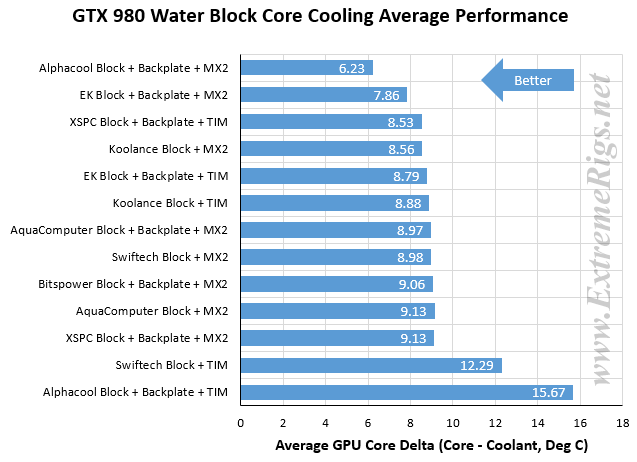
Here we can see that 9/11 data points are within 0.5C. This along with the low absolute values shows just how overkill water cooling really is for a low power GPU like the GTX980.
VRM Cooling
While AMD give us access to a temperature probe built into the VRM section Nvidia does not. Our probe was therefore inserted between a thermal pad and the body of a VRM IC located in the middle of the VRM area. Because it measures IC case temperature and has a thermal pad touching it the temperatures will be significantly lower than the internal silicon temperatures of the IC.
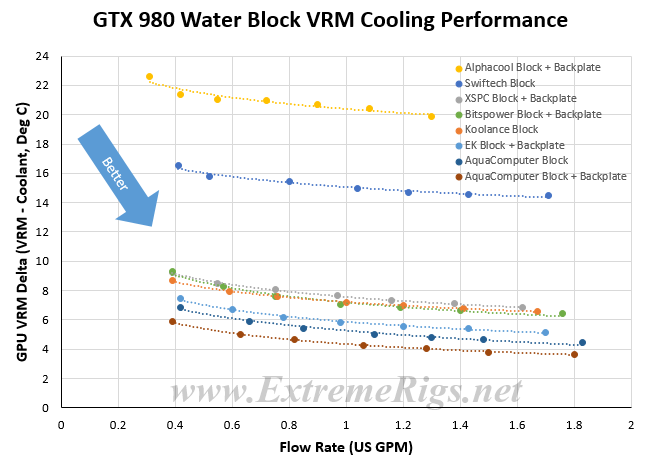 Coolant flow has a weak effect on VRM temps, particularly for blocks with poor performance. Let’s therefore average this to see relative performance more clearly:
Coolant flow has a weak effect on VRM temps, particularly for blocks with poor performance. Let’s therefore average this to see relative performance more clearly:
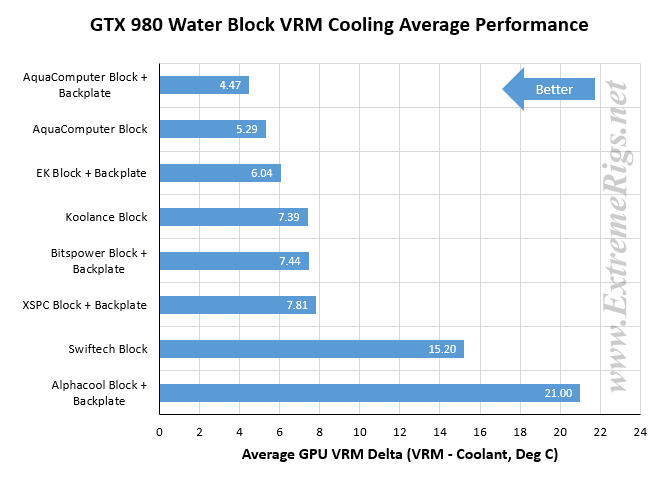 Aqua Computer’s VRM temperatures are amazing just as they were on the R9-290x. The difference vs the R9-290x block is that the mini backplate has enabled the block on it’s own to get enough mounting pressure on the VRMs and therefore also acheive great cooling. The R9-290x block ran out of screw thread before we could get good pressure or good temps unless we used the backplate. Again we see that the active backplate does offer tangible performance gains, but given the already amazing performance of the block it is far from necessary.
Aqua Computer’s VRM temperatures are amazing just as they were on the R9-290x. The difference vs the R9-290x block is that the mini backplate has enabled the block on it’s own to get enough mounting pressure on the VRMs and therefore also acheive great cooling. The R9-290x block ran out of screw thread before we could get good pressure or good temps unless we used the backplate. Again we see that the active backplate does offer tangible performance gains, but given the already amazing performance of the block it is far from necessary.
Onwards for the summary!








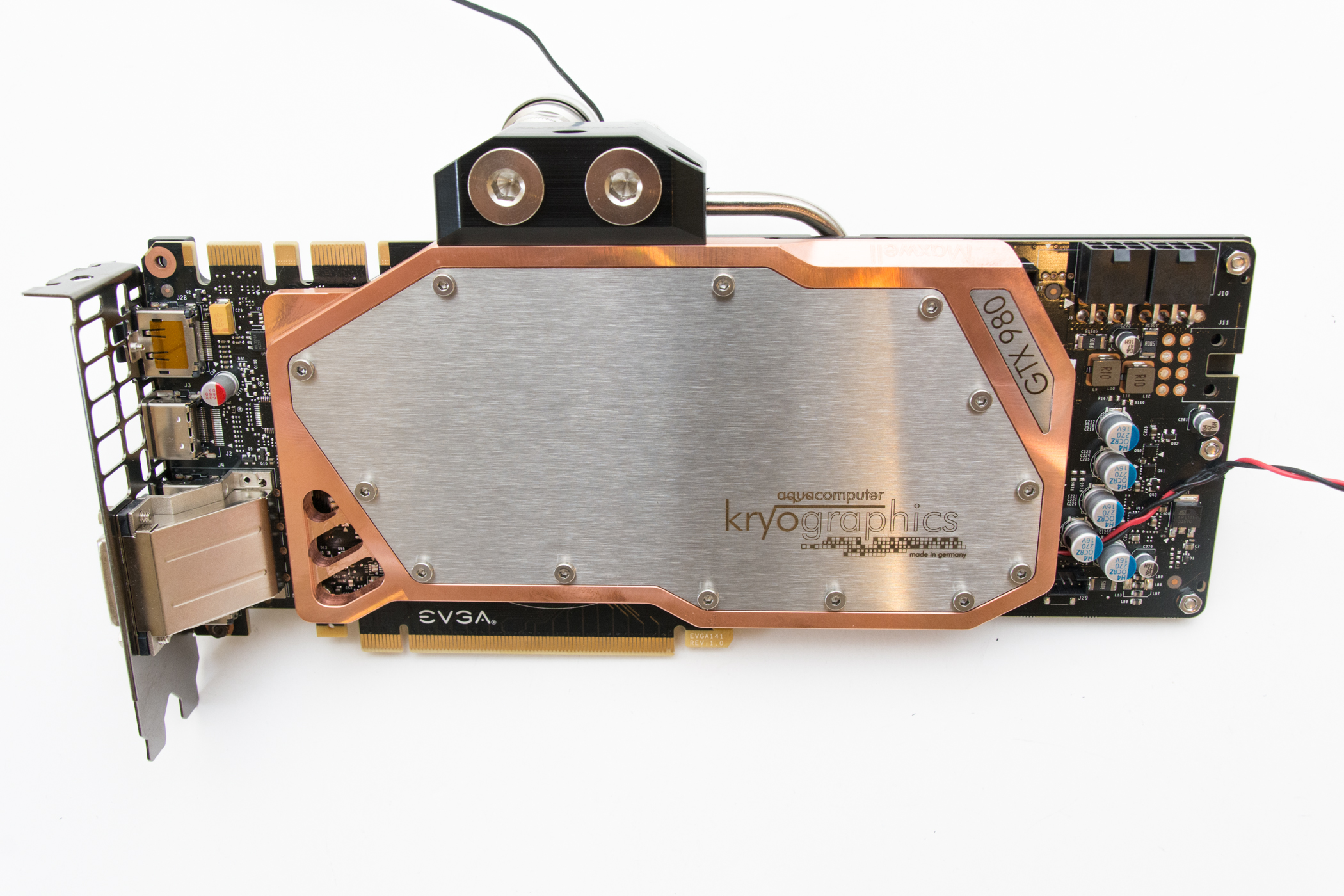
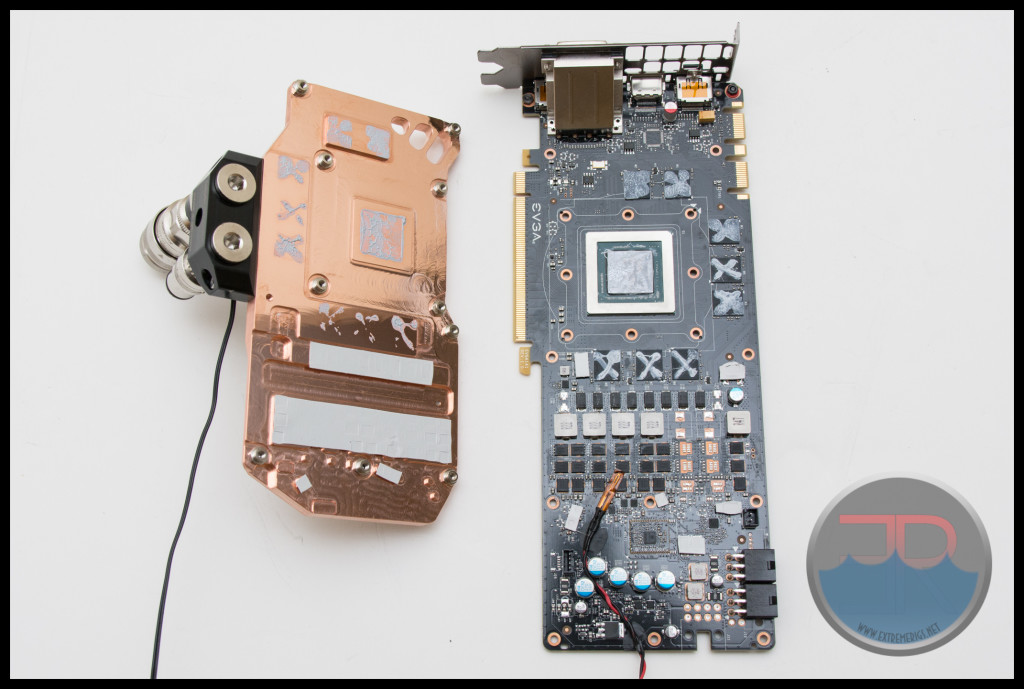



[…] AquaComputer Kryographics for GTX 980 Review – AquaComputer’s GTX 980 Water Block &… […]
[…] AquaComputer Kryographics for GTX 980 Review – AquaComputer’s GTX 980 Water Block &… […]
Do you know if the 980Ti version would have a compatibility issue with the Asus X99 Deluxe. I really want to wait for watercool to release their acrylic heatkiller version, buy there is release in site.
[…] Forum soll es jetzt schon lieferbar sein, aber steht nach wie vor die ewig langen Lieferzeiten. AquaComputer Kryographics for GTX 980 Review – AquaComputer's GTX 980 Water Block & Active Backp… R9-290x GPU Waterblock Roundup! – ExtremeRigs.net Wegen dem Liefertermin Shoggy per PM […]
Comments are closed.